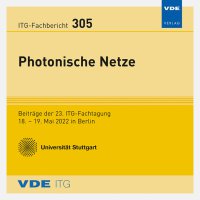Time Adaptive Probabilistic Shaping for Combined Optical/THz Links
Conference: Photonische Netze - 23. ITG-Fachtagung
05/18/2022 - 05/19/2022 at Berlin
Proceedings: ITG-Fb. 305: Photonische Netze
Pages: 8Language: englishTyp: PDF
Authors:
Baek, In-Ho; Elschner, Robert; Maassen, Andreas; Schubert, Colja; Freund, Ronald (Fraunhofer Institute for Telecommunications, Heinrich-Hertz-Institute, Berlin, Germany)
Bart, Frederik; Meier, Fred; Hellmann, David (Chair of Climatology, Institute of Ecology, Technische Universität Berlin, Berlin, Germany)
Abstract:
By exploiting the large bandwidth in the frequency band around 300 GHz, THz communications are a highly anticipated technology for future converged fiber-optical & THz-wireless access and backhaul networks because of the high achievable data rates. However, unlike in fiber-optical communications, the transmission quality over the THz wireless link is highly influenced by weather-dependent atmospheric losses, resulting in dynamically varying signal-to-noise ratios (SNR). Probabilistic amplitude shaping (PAS) has proven itself a powerful method that can adapt the signal transmission to changing channel dynamics. Additionally, signal shaping results in a gain over uniform QAM signaling, which can asymptotically amount up to 1.53 dB for arbitrarily high constellation cardinalities. We investigate the applicability of PAS for an outdoor THz wireless link in simulations with realistic models of the weather-dependent loss. The link performance is evaluated in terms of achievable information rate (AIR) and bit error ratio (BER). Optimal shaping entropies are determined to adjust error rates to a given forward error correction (FEC) threshold under a varying SNR, resulting in a tradeoff between the net data rate and the error rates. Furthermore, the optimal choice for the base constellation with respect to complexity, capacity, and reliability is evaluated. Finally, link performance statistics are evaluated using real weather data.


